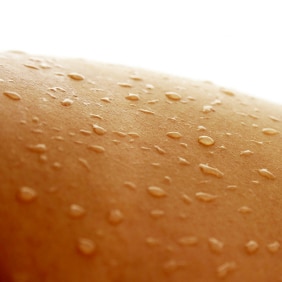Ellie Goulding created waves when she said doesn’t shower after working out. With summer just around the corner, it’s a good time to talk about body odor (BO), or in “medicalese,” bromhidrosis.
Bromhidrosis refers to body odor that is sweat related. Now, everyone has body odor. What defines bromhidrosis? Unfortunately, there is no smell-o-meter that defines bromhidrosis. It’s a combination of an individual’s own perception of his or her smell. In addition, a history of close contacts who may have also noticed significant body odor is also useful. Basically, bromhidrosis is diagnosed when a person’ own smell affects their self-esteem, quality of life, and social behavior.
What You Need to Know About Sweat
There are two main types of sweat. One type of sweat is produced by glands in your skin called eccrine glands. This type of sweat is designed mainly to keep you cool on a hot day during exercise.
The second type of sweat is made by specialized apocrine glands. These glands are located only in specific locations of the body such as the groin and armpits. Apocrine sweat has proteins in it. The bacteria that live on your skin then degrade these proteins, creating compounds that lead to body odor.
Both Eccrine and Apocrine Sweat Can Cause Bromhidrosis
Eccrine bromhidrosis most commonly occurs on the feet. The feet are particularly susceptible to this kind of sweat because with shoes and socks, the sweat has nowhere to evaporate. This can lead to a moist environment where skin bacteria can live and thrive. This overgrowth can lead to an unpleasant smell.
Apocrine bromhidrosis in the armpits in the most common site of bromhidrosis. The armpits are an area where a wide variety of bacteria live. For example, Corynebacterium is a type of bacteria is notorious for creating compounds that lead to body odor.
Bromhidrosis Can Be Local or All Over
Most often, bromhidrosis is localized. What we mean is that the offensive odor can be pinpointed to a specific anatomical location (eg, feet, armpits, or groin). Sometimes, the entire body can also be affected. This is called generalized bromhidrosis.
What Increases the Risk of Bromhidrosis?
Studies on the sweat glands themselves suggest that more sweat glands and larger sweat glands are associated with bromhidrosis.
There are also several medical conditions that predispose individuals to bromhidrosis. Hyperhidrosis, or excess sweating, is one common cause. Diabetes and obesity are both risk factors as well. Moisture and a lack of sweat evaporation in skin fold areas both can lead to bromhidrosis. Kidney problems, liver failure, and even gout can also be associated with bromhidrosis. Rarer causes of bromhidrosis include some genetic and metabolic disease. Diet can also be an influence for some individuals. Generally, this leads to whole body bromhidrosis. Notorious culprits include onions, garlic, or curry.
Skin problems, most commonly localized infections, can also lead to localized bromhidrosis. These include intertrigo, pitted keratolysis, and erythrasma. This can happen on the armpits or feet. Topical or even oral antibiotics are needed to treat these conditions.
Finally, hygiene is important too. But, this doesn’t necessarily equate to the need for daily washing, even after working out. Excess washing can lead to irritated, “angry” skin. Excessive use of perfumes and colognes can even cause allergic contact dermatitis. More often, hygiene contributes to bromhidrosis in vulnerable populations such as the homeless.
What Can You Do?
- Treat any underlying medical condition or skin problem that may be leading to bromhidrosis. This may include visiting your dermatologist to ensure there is no skin infection that is the source of the bromhidrosis.
- Reduce sweating with over-the-counter antiperspirants; other prescription-strength treatments can often be helpful too.
- Hygiene is important by very specific to the individual. There is no “recipe,” because everyone’s sweat glands, sweat rate, and skin bacterial composition are different. If you find yourself washing or scrubbing multiple times a day, leading to skin irritation, definitely ask your doctor for help. Bromhidrosis is often in the eye (or nose) of the beholder.
We’ll also mention that there is an FDA-cleared medical device that can be used to treat bromhidrosis. The technology is called miraDry. This can be helpful to many patients but also comes as an out-of-pocket price.
Last modified on October 18th, 2018 at 6:46 pm
